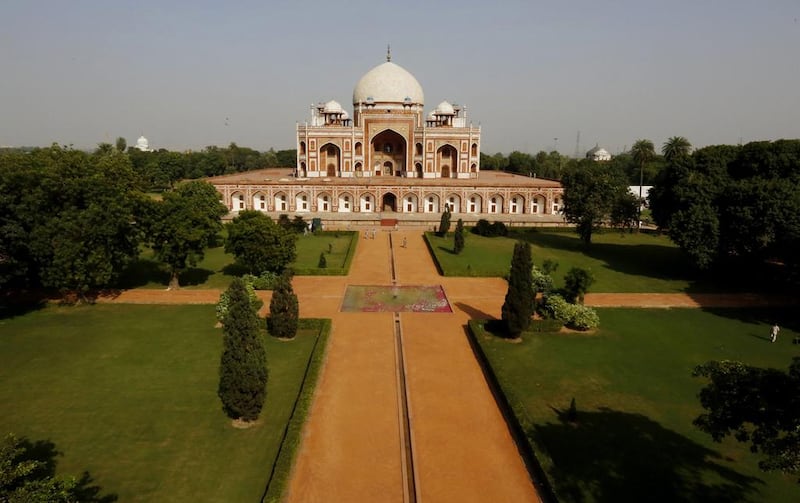NEW DELHI // For more than 600 years its red sandstone minarets and grand white onion-shaped dome have dominated south Delhi’s leafy skyline and stood as one of the finest examples of architecture from the Mughal empire.
But over the past two centuries, Humayun’s Tomb, built to honour the second Mughal emperor, has suffered from shoddy repair work, an encroaching population and general neglect.
This week however, the monument, reopened after a massive six-year restoration project.
The 16th Century tomb, a Unesco World Heritage site, which inspired the Taj Mahal and other Mughal buildings, was refurbished largely by funding from the Aga Khan Trust for Culture.
In order to restore the original designs, craftsmen were brought in from Uzbekistan and Egypt to train the local artisans from nearby slums to sculpt, paint and landscape the ceilings, floors, lighting of all the structures, including the sprawling garden enclosure.
One of the tomb’s most distinctive features, small domes speckled with peacock blue tiles, a legacy of the Persian influence on Mughal architecture, has now been fully restored after disappearing for more than 200 years.
“We wanted to respect the original builders intentions,” said Ratish Nanda, the project director.
The tomb was ordered to be built for Humayun by his widow, Biga Begum, 14 years after he died. She employed the Persian architect Mirak Mirza Ghiyath and the tomb was completed in 1571 at a cost of 1.5 million rupees (Dh87,000).
Humayun is widely credited for introducing to India, Persian artists who blended local art with Islamic architecture.
“The whole point of the Humayun’s tomb was that the Mughal builders were replicating Quranic description of paradise,” said Mr Nanda “The holy Quran repeatedly promises the faithful gardens beneath which the rivers flow as the final resting place. The Mughals took that idea and created this, with gardens and channels of water.”
During the restoration, workers had to remove thousands of tonnes of concrete from the roof and thousands of square metres of cement from the walls, ceilings, and floors which had been used to keep the mausoleum from crumbling away, Mr Nanda said.
Craftsmen then worked on the main dome, filling it with the traditional mixture of lime plaster with marble dust and egg whites to make it airtight.
“The mixing is a tedious process but once used survives for hundreds of years,” Mr Nanda said.
Other members of the ruling Mughal family were later buried at the tomb and the site contains 150 graves, according to Unesco.
The son of Babur, Humayun, helped his father conquer India and ascended the throne in Agra in 1530 at the age of 23. Inexperienced in administration and ruling at such a young age, he lost the throne to Afghan leader, Sher Shah, but returned ten years later in 1556, reigning briefly for six months before his death, as a result of falling down the stairs of his library.
Almost a hundred years later, Humayun’s great-grandson, Shah Jahan would go on to use the Delhi tomb as an inspiration to build the grand marbled mausoleum of Taj Mahal in Agra, in memory of his wife.
As the Mughal rule in India fell to the British, the last Mughal emperor, Bahadur Shah Zafar was hunted down and taken prison at Humayun’s tomb in 1857.
During the partition in August 1947, the tomb became a camp for Muslims migrating to the newly founded Pakistan.
In the book City of Djinns: A Year in Delhi, published in 1993, historian and author William Dalrymple described the tomb as: “Like some elderly courtesan, the tomb tries to mask its imperfections beneath thick layers of make-up; its excesses of ornament are worn like over-applied rouge.”
The tomb was reopened on Wednesday by India’s prime minister Manmohan Singh.
sbhattacharya@thenational.ae





